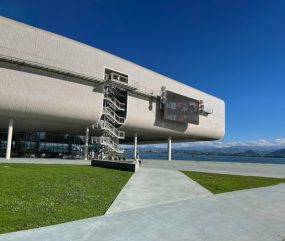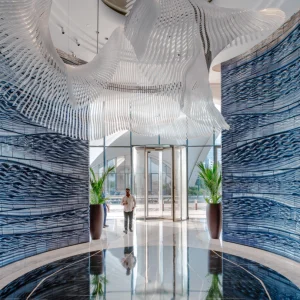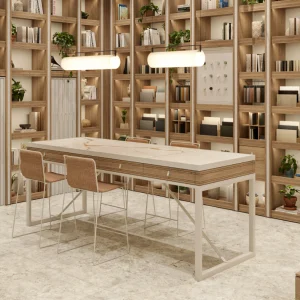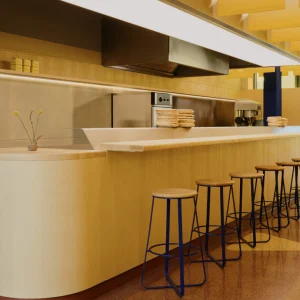
I KNEW NOTHING about the Japanese artist Shimabuku when I was invited to Centro Botin in Santander to see his first solo show in Spain: Citrus, Octopus, Human. Frankly, they had me at ‘octopus’. And the promise that the artist would be creating a range of homes for these wily and intelligent creatures, on the seabed. What clinched it was the chance to visit Renzo Piano’s lightweight cultural centre, its curvaceous form perched – somewhat octopus like – on multiple legs, on the harbour.
Animals of many kinds, as well as vegetables, have been a feature of Shimabuku’s work (full name Michihiro Shimabuku) since the 1990s. But it’s the relationship of plant and species to a particular place and people that intrigues him. How he interprets these relationships is what gives his work traction. For example, he spent some time in the UK for his commission for the Liverpool Biennial (2006) and found our obsession with fish and chips fascinating. He made gentle fun of this passion with his resulting film, Fish and Chips, depicting an imagined ‘romance’ between an actual potato and a fish.
 Centro Botin is lifted on stilts so that the pedestrians of Santander get an uninterrupted view of the sea
Centro Botin is lifted on stilts so that the pedestrians of Santander get an uninterrupted view of the sea
It is his regular encounters with octopuses that take centre stage for this show – because, as he said at the opening, he discovered the octopuses in Santander are exactly the same as those in Japan, ‘unlike the people’, he quipped.
One of three commissions made for this show, Going to meet the Octopuses in Santander (2024), draws on two previous experiments from the early 2000s, also in the exhibition. In one he explored octopus tastes, having noted that they tend to pick up certain stones or shells and carry them around with them, as if they have formed an attachment. So he made some beautiful glass objects and left them on the seabed to see which the octopuses chose; there are some delightful photos of them, holding and hugging their chosen objects, as if they are truly treasuring them. In another work, for the Albisola Biennial, he tried his hand at creating ceramic vessels to lay along the seabed and capture the octopuses – a traditional practice still used in Japan but fallen out of fashion in Italy; it was moderately successful.
For Santander, Shimabuku combined both tactics, bringing a variety of glass vessels, from Japan and San Francisco; some plain and others vibrantly coloured. The octopus responses were captured in an enchanting film screened alongside a plinth showing the full range of vessels. Most of these, in the film, have indeed been successfully adopted as homes, by slippery occupants who stare balefully at the camera as Shimabuku points it into the rim. One even makes a grab for him, the suction pads filling the screen as its tentacles close around his hand.
Of the two further commissions, one riffs off an earlier experiment devised for a residency in the Austrian Alps. He discovered that these prominent mountains were once coral reefs, fully underwater, and inhabited by fishes. So he worked with local children to create fish kites, which they then flew in the sky, repopulating the mountains with sea life. Here, he decides to populate the skies around Centro Botin with flying people, getting locals to draw full-length portraits of themselves and turning them into kites (Flying People (Santander) (2024)). The kites and their filmed flight are shown at one end of this airy gallery floor. At the other we have the citrus of the exhibition’s title. Learning that the museum’s president, Vicente Todoli, has a citrus farm in his home region of Valencia, Shimabuku decided to articulate a question that had recently intrigued him – when washing citrus fruits, he noticed, some of them float, others sink. So in his work Something that Floats/ Something that Sinks (2024), he placed large glass tanks around the end gallery. They are filled with perfect green limes. And indeed, some are floating and others sinking. But – wait a moment – some appear to be moving. Is that possible? The caption suggests that maybe limes can swim. In conversation later, he admits to inserting a current, but only to discover if that would trigger movement. ‘It’s really about discovering something,’ he says.
That joy of discovery is, he says, what motivates him. ‘I just want to be amazed. I am just sharing this with people. Each work I am amazed myself. It’s not like a teaching, it’s more like a sharing – my surprise.’
The ability to inhabit and express a childlike state of wonder is perhaps Shimabuku’s superpower. But what an excellent building in which to articulate that quality. Centro Botin, I find, is one of the most welcoming, porous and inhabitable cultural structures I have encountered. When Renzo Piano proposed his masterplan for a harbourfront site that used to be predominantly car and lorry parking for the adjacent ferry terminal, he deemed that the building should be lifted on stilts so that the pedestrians of Santander get an uninterrupted view of the sea. They can come through the supporting steel poles right up to the water’s edge (with no barriers – a victory of aesthetics and access over health and safety that I can’t imagine being approved anywhere else). They can walk all over the building: there are ladders right onto the roof, and steps up to every level from the outside, so all visitors can avail themselves of the terraces and platforms that loom out over the water, whether the building is open or closed. And the whole area around the museum is now given over to public gardens and recreational space, with the busy road that used to run through it now diverted underground. A nearby outdoor seating area seems to have been adopted by skaters and skateboarders, who flip and clatter away companionably all evening, enjoyed by the promenaders and pedestrians moving through the space, or those sipping wine or coffee outdoors at the Centro Botin café.
And that spirit of access permeates the programme for the building, which includes theatre, film and dance, plus numerous public workshops and events. Speaking with curator and director of programmes Barbara Rodrigùez Muñoz, it seems that this museum has been devised primarily for the benefit of Santander’s citizens, rather than as a glittering lure for cultural tourists (unlike its not too distant neighbour the Guggenheim Bilbao). Every resident has free membership to the arts programme to encourage repeat visits and ownership. It’s all thanks to the ambitions of the Botin Foundation, established in the 1960s for the economic and cultural development of the Cantabria region, which until then had largely relied on agriculture and fishing. Says Muñoz: ‘Since the 1990s the foundation has been running an art and culture education programme. And because these activities had grown was why we needed this building, which opened seven years ago.’
One of the inspiring underpinnings for their educational outreach and research is a belief that access to arts and culture is good for peoples’ emotional intelligence, mental health and resilience. The foundation has been working with Yale University and a number of other institutions to prove these benefits, since 2012, with notable success.
Having studied culturally led regeneration over many years, and locations, it’s heartening to see a city about to benefit from further cultural assets – Banco Santander and Reina Sofia are opening new arts spaces in the next few years – but within a context where expansion has been driven by an effort to enrich the lives, the minds, hearts and emotional health of the locals. We’ll be watching this space with interest.





